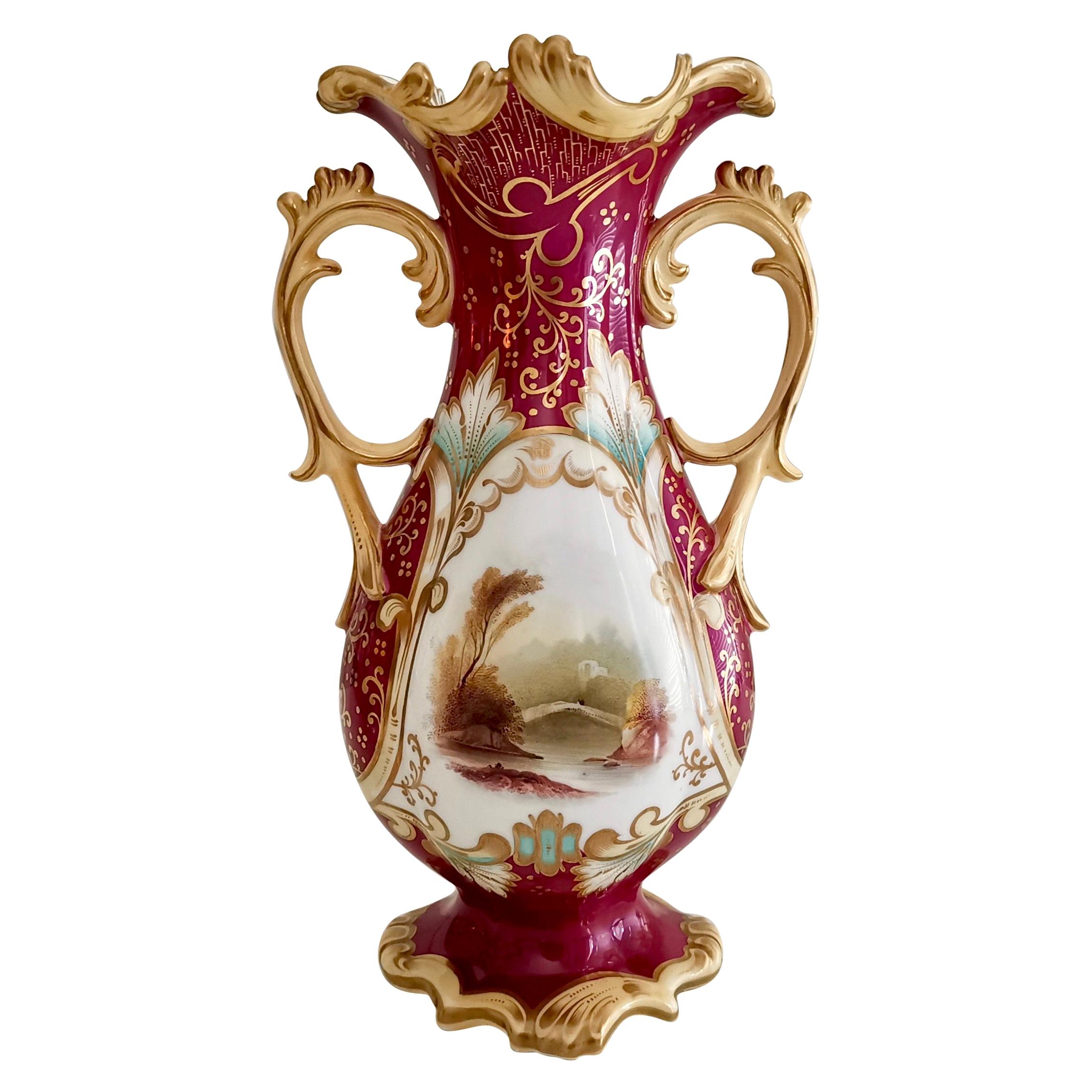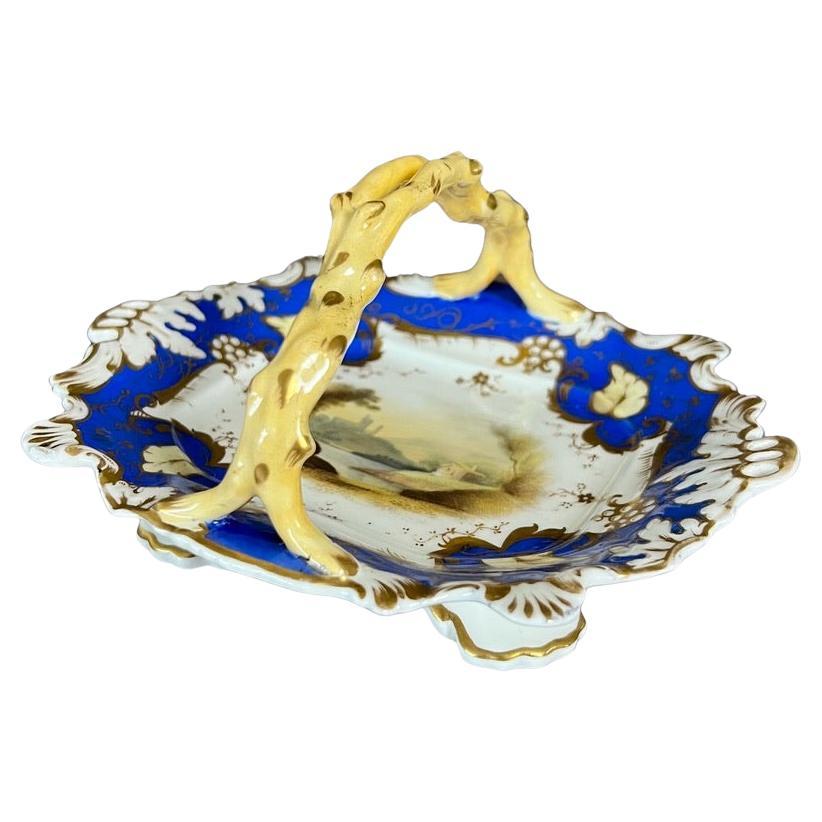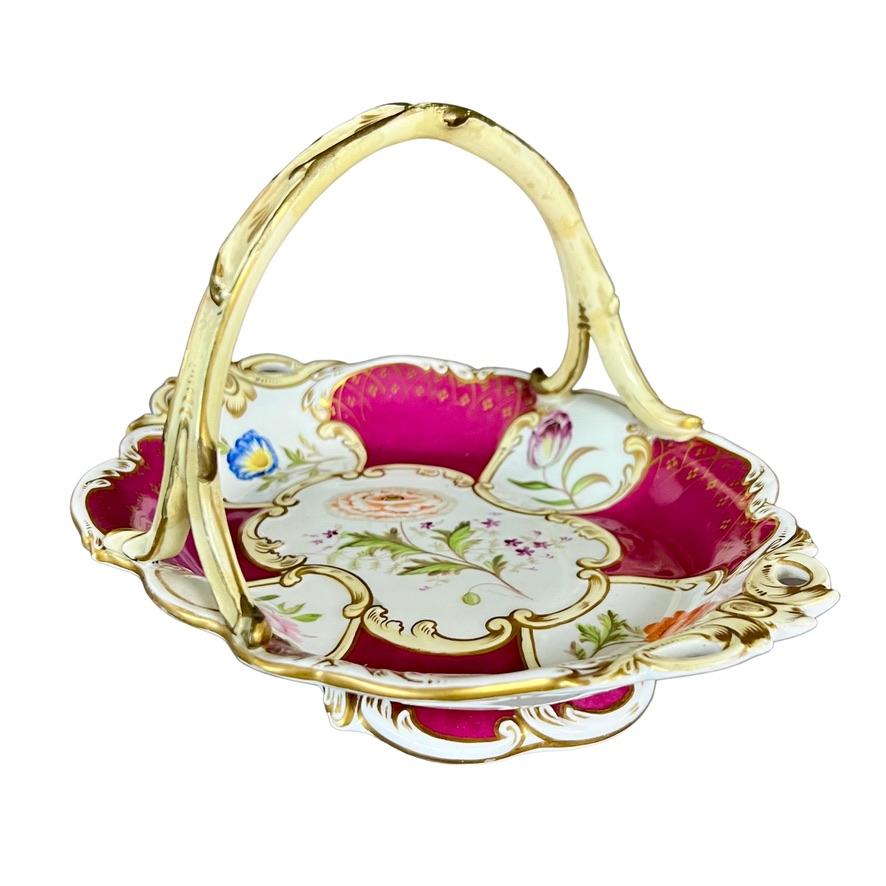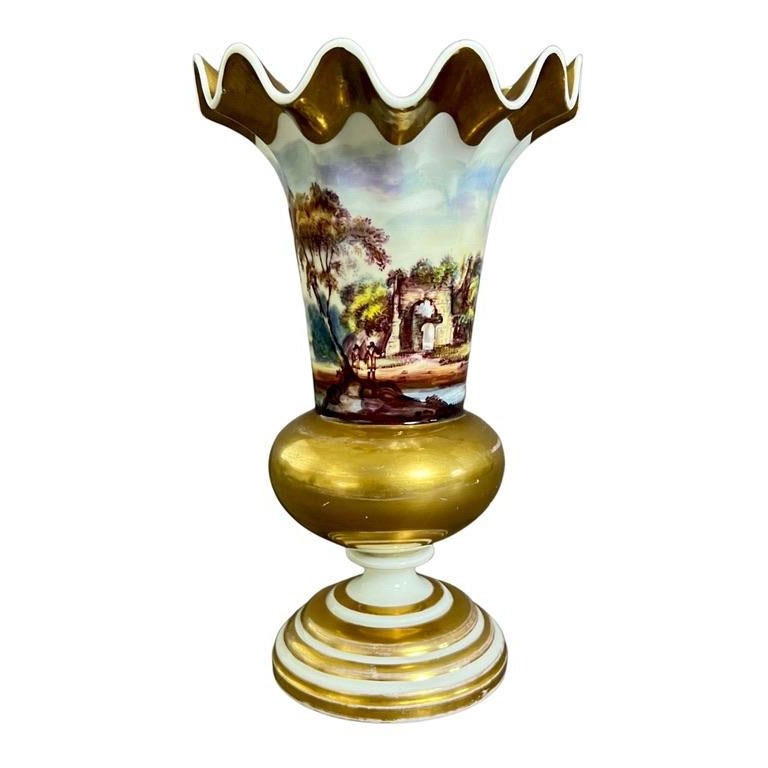Items Similar to Samuel Alcock Griffin Vase, Cobalt Blue with Landscapes, Rococo Revival, ca 1840
Want more images or videos?
Request additional images or videos from the seller
1 of 15
Samuel Alcock Griffin Vase, Cobalt Blue with Landscapes, Rococo Revival, ca 1840
About the Item
On offer is a beautiful porcelain vase made by Samuel Alcock in about 1840 during the Rococo Revival era. The vase has griffin-shaped handles, a cobalt blue ground, lavish gilt and a beautiful landscape painting.
Samuel Alcock was a major potter in Staffordshire between the 1820s and 1840s. He is probably one of the most under-appreciated potters of that era, creating a huge and very high quality output but as he didn't mark his wares, many got attributed to other factories and his name largely forgotten. Only recently are people starting to recognise the extraordinary quality of these wares, and this piece is a great example of the creativity and beautiful of their Rococo Revival designs.
The vase is decorated in deep cobalt blue with a gorgeous hand painted landscape on one side and a lavish gilt detail on the other. The landscape is painted in beautiful autumnal colors. The most stunning feature of the vase is its two handles, which consists of griffins. The neck of the vase is perforated, pointing to the fact that it might have doubled as a potpourri vessel if sold with a lid. The rim is adorned with a crown-like moulded decoration.
The Rococo style was originally a style of the 18th century. After the Baroque style, which was highly symmetrical and well-designed as it aimed to express the perfection of God, the Rococo style was a reaction that expressed the unpredictability and flow of nature. "Rococo" is derived from the French word "rocaille", which stands for a mass of pebbles that are self-organised in a completely unpredictable mess, for instance on the beach or in the mountains. Rococo moved away from the stranglehold that religion had on the arts: it was capricious, asymmetrical, charming and worldly. As Europe got mired in various wars between Germany, France and Britain, the general style got much more austere again and people embraced neo-classicism. But in the 1830s and 1840s, the seemingly unlimited fortunes of the Industrial Revolution sparked a revival of Rococo, once again creating natural shapes that are not symmetrical and don't particularly make rational sense. This beautiful vase is made in this style; nothing about it seems very sensible but it is beautiful and perfectly serves its purpose.
The vase is unmarked, as was normal at the time, but has the pattern number 208. As this is a very low pattern number it is assumed that the vase, which is clearly in a style from circa 1840, made use of a much earlier pattern.
Condition report The vase is in good antique condition. The body of the vase is in perfect condition so it is safe for use filled with water. There are some small and professionally done repairs to the griffins, that are not visible without special UV light. There is a firing crack in the neck of the vase; this has happened during production and has been glazed over. The vase is slightly lop-sided; this is often the case with these items as they were very difficult to fire and could easily sag in the kiln. There is some rubbing to the gilt, as can be expected. The landscape painting is in excellent condition.
Antique British porcelain is never perfect. Kilns were fired on coal in the 1800s, and this meant that china from that period can have some firing specks from flying particles. British makers were also known for their experimentation, and sometimes this resulted in technically imperfect results. Due to the shrinkage in the kiln, items can have small firing lines or develop crazing over time, which should not be seen as damage but as an imperfection of the maker's recipes, probably unknown at the time of making. Items have often been used for many years and can have normal signs of wear, and gilt can have signs of slight disintegration even if never handled. I will reflect any damage, repairs, obvious stress marks, crazing or heavy wear in the item description but some minor scratches, nicks, stains and gilt disintegration can be normal for vintage items and need to be taken into account.
There is widespread confusion on the internet about the difference between chips and nicks, or hairlines and cracks. I will reflect any damage as truthfully as I can, i.e. a nick is a tiny bit of damage smaller than 1mm and a chip is something you can easily see with the eye; a glazing line is a break in the glazing only; hairline is extremely tight and/or superficial and not picked up by the finger; and a crack is obvious both to the eye and the finger.
Dimensions height 24cm (9.5"), width (incl. both handles) 19cm (7.5"), depth 11.5cm (4.5").
- Creator:Samuel Alcock & Co. (Maker)
- Dimensions:Height: 11 in (27.94 cm)Width: 6.25 in (15.88 cm)Depth: 5 in (12.7 cm)
- Style:Rococo Revival (Of the Period)
- Materials and Techniques:
- Place of Origin:
- Period:
- Date of Manufacture:circa 1840
- Condition:Wear consistent with age and use. Very good condition, small invisible professional repairs to the griffins, some rubbing to the gilt, a firing crack from production to the neck of the vase - see pictures.
- Seller Location:London, GB
- Reference Number:
About the Seller
5.0
Platinum Seller
These expertly vetted sellers are 1stDibs' most experienced sellers and are rated highest by our customers.
Established in 2016
1stDibs seller since 2019
208 sales on 1stDibs
Typical response time: <1 hour
- ShippingRetrieving quote...Ships From: London, United Kingdom
- Return PolicyA return for this item may be initiated within 14 days of delivery.
More From This SellerView All
- Samuel Alcock Porcelain Vase, Maroon with Landscapes, Rococo Revival, ca 1840By Samuel Alcock & Co.Located in London, GBOn offer is a beautiful porcelain vase made by Samuel Alcock circa 1840 during the Rococo Revival era. It has a maroon ground and a stunning landscape painting. Samuel Alcock was on...Category
Antique 1840s English Rococo Revival Vases
MaterialsPorcelain
- Samuel Alcock Porcelain Basket, French Blue, Landscape, Rococo Revival ca 1830By Samuel Alcock & Co.Located in London, GBA small porcelain basket in Rococo Revival style with scroll and shell moulded borders, pierced handles on both ends, a pale yellow twig handle, a French blue ground with pale yellow foliage and a fine landscape painting in the centre. This would make a perfect gift as a trinket dish - these baskets were often used to collect visting cards from guests. Pattern unknown Year: ca 1830 Size: 17.5cm (6.8”) long, 9cm (3.5”) tall Condition: excellent The Samuel Alcock factory was operative in Staffordshire between 1822 and 1856, after which it was bought by Sir James Duke and Nephews. The factory started as a partnership between the young Samuel Alcock and the older Ralph Stevenson, who provided the factory and capital. Alcock quickly took the factory to great heights, building one of the biggest factories of its time. Alcock jumped on the new Rococo Revival fashion and served a huge new middle class market. The reason we now don't hear much about Samuel Alcock porcelain...Category
Antique 1830s English Rococo Revival Decorative Baskets
MaterialsPorcelain
- Samuel Alcock Potpourri Vase, Green, Double Cover, Landscape, Flowers, ca 1835By Samuel Alcock & Co.Located in London, GBA potpourri vase with double cover, pale yellow/beige ground with apple green details, Rococo shape with fruit finial and scroll handles and foot; a flower reserve on one side and a ...Category
Antique 1830s English Rococo Revival Vases
MaterialsPorcelain
- Samuel Alcock Porcelain Teapot, Blue, Gilt and Flowers, Rococo Revival ca 1837By Samuel Alcock & Co.Located in London, GBA teapot with cover in the “rustic bean” shape, cobalt blue ground with gilt acanthus motif and finely painted flower posies on the belly of the teapot Pattern 5782 Year: ca 1837 Si...Category
Antique 1830s English Rococo Revival Tea Sets
MaterialsPorcelain
- Samuel Alcock Porcelain Basket, Rococo Revival, Maroon, Flower Reserves, ca 1835By Samuel Alcock & Co.Located in London, GBA maroon ground basket in Rococo Revival style with pierced pale yellow ends, a twig handle and five flower reserves with single flowers. Pattern 2/5610 Year: ca 1835 Size: 22.5cm (8.75”) long, 13cm (5”) tall Condition: handle has been repaired, see last picture; some rubbing This basket forms part of the Murray Pollinger Collection of Samuel Alcock Porcelain...Category
Antique 1830s English Rococo Revival Decorative Baskets
MaterialsPorcelain
- Samuel Alcock Porcelain Coffee Cup, Orange Imari Flowers, Rococo Revival ca 1830By Samuel Alcock & Co.Located in London, GBThis is a beautiful coffee cup and saucer made by Samuel Alcock around 1830, which was the Rococo Revival era. The set is decorated with a bold Imari pattern and has a "ring-moulded" shape. Samuel Alcock was one of the many potters in Staffordshire such as Spode, Coalport, H&R Daniel and many others during the 1830s and 1840s. He was perhaps not the most well-known of potters but produced very high quality wares and original designs, often standing out for their bright choice of colours and beautiful shapes. The Alcock factory is not well documented so although they had a huge output, items are often mis-identified and we don't know much about the production process of artists, even though the wares have a very high quality that equals that of the more well known factories. The Rococo style was originally a style of the 18th Century. After the Baroque style, which was highly symmetrical and well-designed as it aimed to express the perfection of God, the Rococo style was a reaction that expressed the unpredictability and flow of nature. "Rococo" is derived from the French word "rocaille", which stands for a mass of pebbles that are self-organised in a completely unpredictable mess, for instance on the beach or in the mountains. Rococo moved away from the stranglehold that religion had on the arts: it was capricious, asymmetrical, charming and worldly. As Europe got mired in various wars between Germany, France and Britain, the general style got much more austere again and people embraced neo-classicism. But in the 1830s and 1840s, the seemingly unlimited fortunes of the Industrial Revolution sparked a revival of Rococo, once again creating natural shapes that are not always symmetrical and don't particularly make rational sense. This coffee cup can...Category
Antique 1830s English Rococo Revival Tea Sets
MaterialsPorcelain
You May Also Like
- Zsolnay Hungarian Floral Reticulated Porcelain Vase with Cobalt Blue PanelsBy ZsolnayLocated in Bishop's Stortford, HertfordshireA very fine and elegant Hungarian porcelain twin handled vase with floral reticulated designs and contrasting blue glazed panelling by renowned maker Zsolnay and dating from around 1...Category
Antique 1890s Hungarian Art Nouveau Vases
MaterialsPorcelain
- Pair of French Old Pairs Painted Porcelain Vases with Scenic Landscapes, C. 1840Located in Hollywood, SCPair of French Old Paris hand painted porcelain vases with scenic landscapes, Mid 19th Century Dimensions of each are 12 Tall / 4.5...Category
Antique 1840s French Louis Philippe Vases
MaterialsPorcelain, Paint
- Bumps 2.0 Blue Cobalt Vase by Arkadiusz SzwedLocated in Geneve, CHBumps 2.0 blue cobalt vase by Arkadiusz Szwed Dimensions: L 16 x W 16 x H 20 cm Materials: Porcelain Arkadiusz Szwed designs and produce ceramic...Category
2010s Polish Modern Vases
MaterialsPorcelain
- Antique Pair English Porcelain Green Samuel Alcock Vases Urns Still Life FlowerLocated in Dublin, IrelandAn exceptionally fine quality identical pair of English rococo revival twin handle mantle vases, firmly attributed to Samuel Alcock, circa second quarter of the 19th century. Eac...Category
Antique 19th Century English Rococo Revival Urns
MaterialsCeramic, Porcelain
- Pair of Vases with LandscapesLocated in New York, NYPair of porcelain vases with painted decoration of landscapes with birds, Italian, 1920s.Category
Early 20th Century Italian Vases
- A Rare Meissen Porcelain Cobalt Blue Ground Platinum & Gold Floral Painted VaseBy Meissen PorcelainLocated in New York, NYA Highly Important and Rare Meissen Porcelain Cobalt Blue Ground Vase with Platinum and Gold Hand-Painted Decoration. An exquisite and fine C...Category
Antique 1860s German Louis XVI Vases
MaterialsPorcelain





